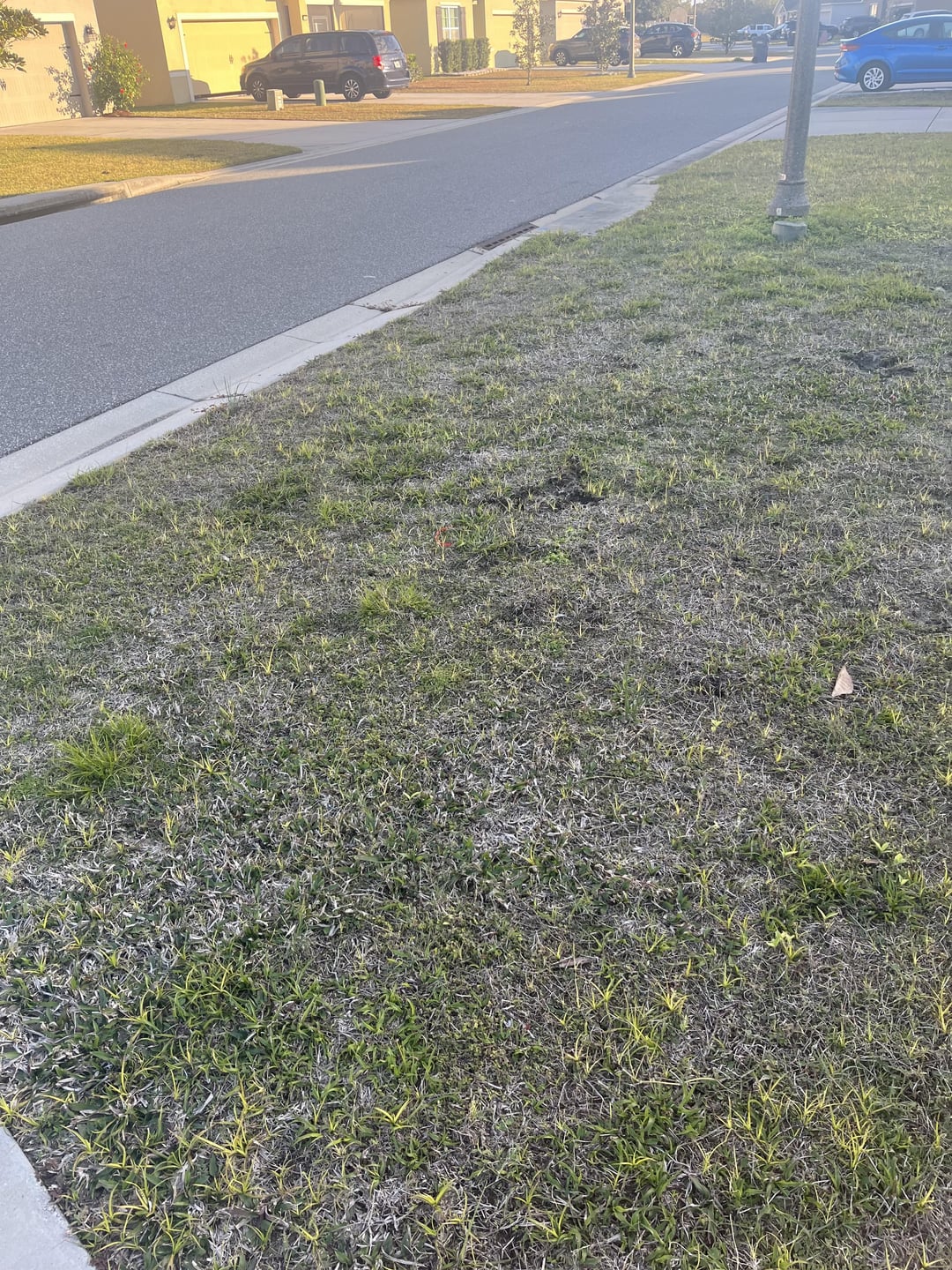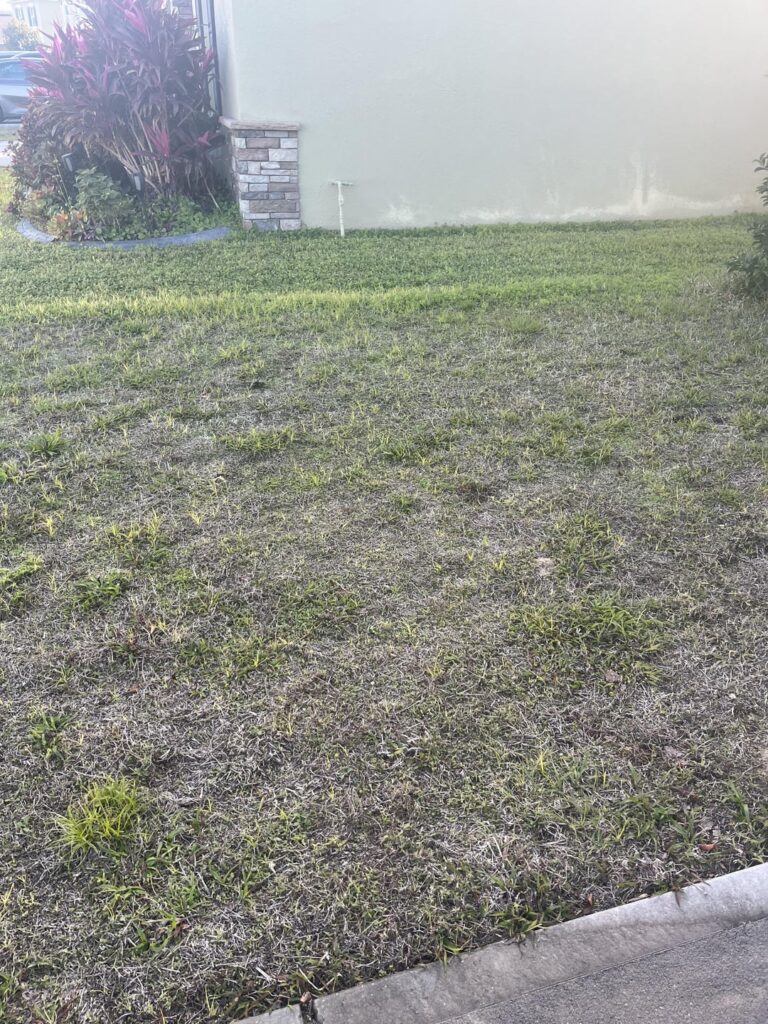


I’m renting this house and I inherited grass that was 3 feet high (we moved in a day earlier than originally scheduled, they told me that they would let us move in early, but that they hadn’t cut the grass yet, I said that was fine)
I signed an agreement to take care of lawn maintenance but it was clearly not watered or taken care of. My landlord has now mandated I get rid of the dead spots. What can I do? In central Florida?
I raked up thatch, overseeded, and have been watering four times a day for 3 weeks. Things are looking a little better but I frankly just want a normal looking lawn. Any help is appreciated.
by cdapp3


2 Comments
Dethatching is a recent trend in lawn care that’s become more common thanks to youtube creators and other non-academic sources. As such, there’s a widespread misunderstanding/misinformation about the topic. This automatic comment has been created in the hopes of correcting some of those falsehoods.
Thatch is the layer of stems and roots, both living and dead, that makes up the top layer of soil. Grass clippings are not thatch and do not contribute to thatch. The thickness of thatch can only be assessed by digging into the soil.
Some thatch is good. While some academic sources say that under 1 inch of thatch is beneficial, most settle for half an inch. Thatch is beneficial for many reasons (weed prevention, traffic tolerance, insulation against high temps and moisture loss, etc) and should not be removed. Over half an inch of thatch may not warrant removal, but the underlying causes should be addressed. An inch or more of thatch SHOULD be addressed. Dethatching as a regular maintenance task, and not to address an actual thatch problem, is NOT beneficial… Again, some thatch is good.
Thatch problems are not typical. Excessive thatch is a symptom of other issues, such as: over-fertilization, overwatering, regular use of fungicides, excessive use of certain insecticides, high/low pH, and the presence of certain grasses (particularly weedy grasses).
Dethatching with a flexible tine dethatcher (like a sunjoe) causes considerable short-term and long-term injury to lawns, and is known to encourage the spread of some grassy weeds like bentgrass and poa trivialis. In some RARE cases, that level of destruction may be warranted… But it should always be accompanied with seeding.
A far less damaging alternative to dealing with excessive thatch is core aeration. Core aeration doesn’t remove a significant amount of thatch, and therefore doesn’t remove a significant amount of healthy grass. BUT it can greatly speed up the natural decomposition of thatch.
Verticutters and scarifiers are also less damaging than flexible tine dethatchers.
For the purposes of overseeding, some less destructive alternatives would be slit seeding, scarifying, manual raking, or a tool like a Garden Weasel. Be sure to check out the seeding guide [here.](https://www.reddit.com/r/lawncare/s/pUsKCxyvwQ)
Additionally, be sure to check the list of causes above to be sure you aren’t guilty of those.
*I am a bot, and this action was performed automatically. Please [contact the moderators of this subreddit](/message/compose/?to=/r/lawncare) if you have any questions or concerns.*
Easy peasy. From what I can see in the pics, there is actually quite a lot of grass… It just doesn’t look like much because the weeds are better at drawing the eye.
– until you control n the weeds, don’t do anything to disturb the soil, like aerate, or god forbid dethatch. That would just worsen future weed problems.
– nuking would not solve any problems… Only delay them until you have grass there that would be susceptible to herbicides (especially when young)
– Fertilize it every 6 weeks while it’s actively growing (soil temps over 60-65F) Use a fertilizer that’s roughly 5:0:1 (so, 25-0-5 for example, doesn’t need to be exact). I’d recommend doing half of the listed label rates until spring (when you get more sunshine, and thus the grass can use more nutrients)
– spray the weeds. Backpack or hand pump sprayer with a flat tip nozzle. You can spot spray every 2-3 weeks, or blanket spray the whole lawn every 4 weeks as needed (though, you might need to cycle products, always read the labels!). When your soil temps are above 60F, you can use any selective broadleaf weed killer that’s safe for your grass, Celsius is always a good bet.
– get the mow height back up. 2 inches minimum. Actually measure it, don’t trust numbers on the mower.
– when soil temps start trending upward in the spring, and hit 50F, apply crabgrass preventer of some sort asap. There’s tons of options, but active ingredient prodiamine would be the best.
– when soil temps hit 70F, water once a week. Water to the point that the soil becomes NEARLY fully saturated.
– when soil temps hit 80F, water twice a week. Same saturation thing.
– when they hit 80F, you might have to go up to 3 or even 4 days a week, but fight as long as you can.
– WHEN crabgrass shows up in June. Spray that with something that contains quinclorac (weed b gon with crabgrass killer for example). Sedgehammer if nutsedge shows up.
– keep constantly fighting weeds through the summer. The sooner you spray a weed, the less of a problem it (and its potential offspring) will be in the future. If a weed doesn’t die within 2 weeks of spraying, hit it again.